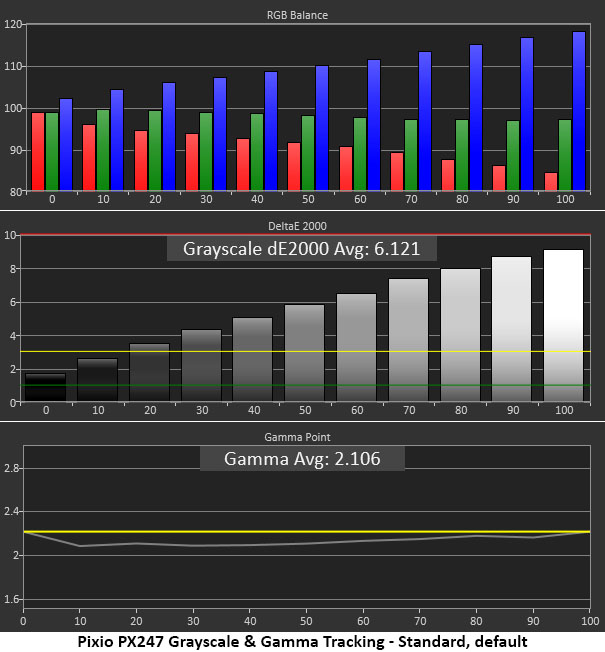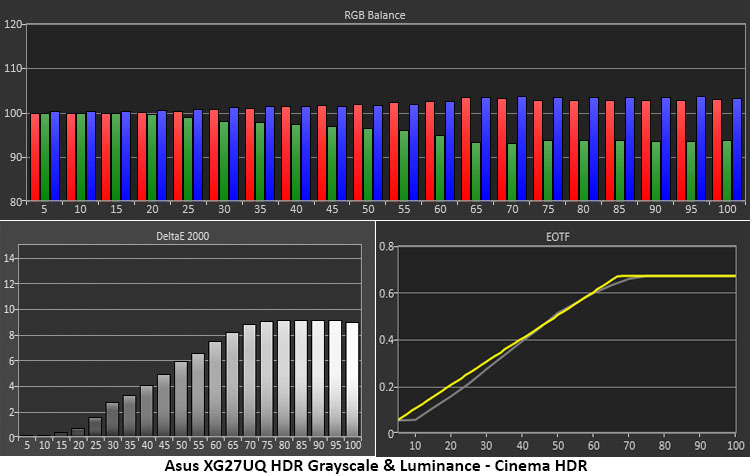Why you can trust Tom's Hardware
The PX247 needs some adjustment from its default settings, which are Standard picture mode and Normal color temp. The image looks blue in tone and lacks pop. Luckily, the fix is pretty easy.
Grayscale and Gamma Tracking
Our grayscale and gamma tests are described in detail here.



The first chart shows the PX247’s default state. The white point is visibly blue from 20% brightness and higher. The tint grows along with brightness until the error at 100% is around a Delta E (dE) of 9. Gamma is reasonably linear but runs a little light (lower values are brighter). Unfortunately, there are no gamma presets to help with that issue, but there are more color temp options.
Simply changing to the Warm color temp made a visible improvement. There are still slight blue errors at 90-100% brightness, but other steps have no visible problems. One could make this change and be satisfied.
Tweaking the precise RGB sliders revealed the PX247’s full potential. After we did this (see our recommended settings on page 1), there were no visible errors, and gamma became ever so slightly better. If you don’t have the means to calibrate, our settings will get you close to these results. At the PX247’s price point, this is excellent performance.
Comparisons




Set to its Normal color temp, the PX247 isn’t impressive, but after a few adjustments, it improves to the top tier. A 1.01dE average is about as good as it gets for any monitor, especially when it costs under $200.
The PX247’s range of gamma values is very tight, which helps offset the light blacks and mid-tones we observed. Though we’d prefer the average to be 2.2, the PX247 isn’t too far off the mark.
Get Tom's Hardware's best news and in-depth reviews, straight to your inbox.
Color Gamut Accuracy
For details on our color gamut testing and volume calculations, please click here.



The PX247’s gamut tests ran similarly to the grayscale benchmarks. In Standard mode with color temp set to Normal, the entire gamut is pulled in the direction of the white point, which is too blue. That error de-saturates red and pulls the secondaries off their hue targets.
Changing the color temp to warm helped somewhat. This reduced the secondary (magenta, cyan, yellow) hue errors, and red became a little more saturated. Dialing in the RGB sliders made the most impact. Red was much better with all other colors near-perfect. We’re impressed to see a 1.49dE average from a $170 monitor.
Comparisons


Though the PX247 doesn’t offer great out-of-box accuracy, it has a lot of potential for the money. At minimum, we recommend changing the color temp to Warm. It improves the color error to a very low 2.43dE. Calibration takes it even further to just 1.49dE, which good enough for second place in our competitive comparison group.
Three of the monitors here, including the other two Pixios, offer extended color gamuts. The Acer and BenQ have a tiny bit more color volume, but it’s an amount that’s invisib;e to the naked eye. The PX247 is an sRGB screen and fills that gamut. The gamut chart shows a slight under-saturation in red, but a little bonus blue makes up for that. We wouldn’t expect to see this screen performing color-critical tasks, but for most work, and certainly for gaming, it is well qualified.
To learn about our HDR testing, see our breakdown of how we test PC monitors.
The G27QC automatically switches over when an HDR10 signal is detected. It applies the proper luminance curve and locks out all image controls except for brightness. Adaptive sync and 165Hz remain in play. There is no dynamic contrast option available, but Gigabyte’s high-contrast VA screen does a reasonable job with HDR content.



HDR Brightness and Contrast
Maximum output in HDR mode is a tad higher than SDR, just over 333 nits. In our comparison group, that puts the G27QC at the bottom. The Cooler Master is blank because it doesn’t have HDR. The top four screens exceed the VESA DisplayHDR 400 standard. The G27QC is saved by its very-low black levels. It’s the best of the screens that lack dynamic contrast. The Asus and ViewSonic panels manipulate their backlights on a frame-by-frame basis to provide the widest possible dynamic range. That is apparent in the third chart with the contrast results. Though the G27QC is respectable among value-oriented monitors, it pales in comparison with the top two screens. Overall though, HDR looks OK with a little more impact than SDR due to accurate rendering of the EOTF luminance curve.
Grayscale, EOTF and Color




Our HDR grayscale test shows a visible green tint in the G27QC’s result. It’s unfortunate that the RGB sliders aren’t available. You can adjust brightness if you wish though we recommend maxing it for the best possible HDR image. The EOTF chart looks good with a slightly-too dark rendering in the lowest steps. The tone-mapping transition point is above 60% which is solid performance.
Considering the gamut chart, we can see a little over-saturation in red and blue, but most targets are fairly close to the mark. Green tracks well until it runs out at around 90%. Hue values are accurate which makes overall HDR color quality quite good.
MORE: Best Gaming Monitors
MORE: How We Test Monitors
MORE: All Monitor Content
Current page: Grayscale, Gamma and Color
Prev Page Brightness and Contrast Next Page Viewing Angles, Uniformity, Response and Lag
Christian Eberle is a Contributing Editor for Tom's Hardware US. He's a veteran reviewer of A/V equipment, specializing in monitors. Christian began his obsession with tech when he built his first PC in 1991, a 286 running DOS 3.0 at a blazing 12MHz. In 2006, he undertook training from the Imaging Science Foundation in video calibration and testing and thus started a passion for precise imaging that persists to this day. He is also a professional musician with a degree from the New England Conservatory as a classical bassoonist which he used to good effect as a performer with the West Point Army Band from 1987 to 2013. He enjoys watching movies and listening to high-end audio in his custom-built home theater and can be seen riding trails near his home on a race-ready ICE VTX recumbent trike. Christian enjoys the endless summer in Florida where he lives with his wife and Chihuahua and plays with orchestras around the state.